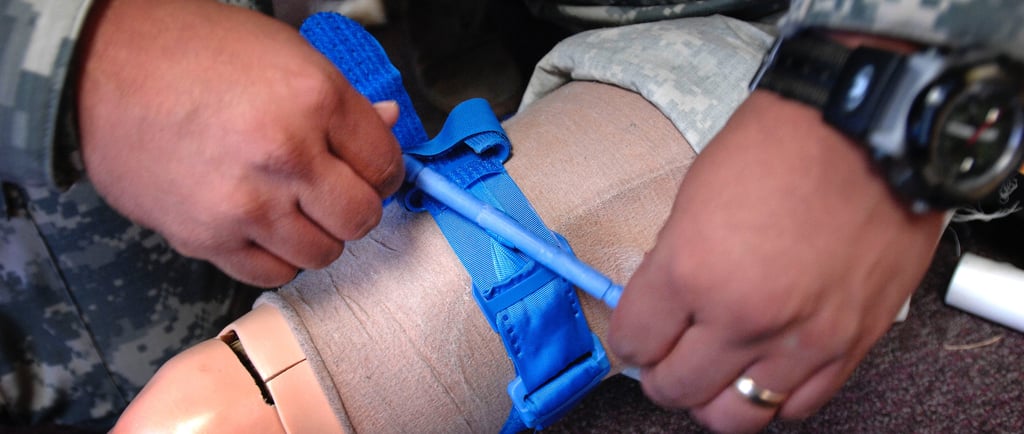Tourniquets: Useful in different scenarios
TCCC
11/24/20244 min read


The tourniquet (TQ) represents one of the most important strategies for safeguarding human lives in the most varied environments.
It can be defined as any device designed to stop bleeding in an anatomical area that allows it.
Both in the civilian world and in military combat environments, traumatic haemorrhage is the biggest preventable cause of death, up to 30% and 90% respectively.
The ‘Tactical Combat Casualty Care’ (TCCC) initiative, a successful attempt to bring together the best available scientific evidence and state-of-the-art clinical practice, adapting them for combat where logistical and personnel constraints do not allow for the level of care we normally have, has made it possible to address, among other injuries, the scourge that exsanguinating haemorrhage represents.
In the Vietnam War, up to 9% of American deaths in combat were due to exsanguinating haemorrhages in the extremities (aka limbs).
As a potentially fatal injury, if not dealt with correctly, exsanguinating or massive haemorrhage should always be the first aspect to be treated. To this end, in the case of extremity haemorrhages, TQ is an essential tool. Characteristics such as its size, weight, ease of use and effectiveness if used correctly make it indispensable in any individual emergency medical bag.
Their widespread use since 2005 has seen a decrease of more than 67% in deaths from haemorrhage, since in operations ‘Enduring Freedom’ and ‘Iraqi Freedom’ they are estimated to have totalled 2.6%. In the presence of an exsanguinating limb injury, the correct use of a TQ can represent a 90 per cent increase in the probability of survival.
As a result, today all allied military personnel carry a TQ with them when deployed in hostile scenarios, as well as in training. Its use by security agencies is also common, and more widespread abroad, where most police officers carry it given the high incidence of incidents involving firearms and bladed weapons, which often result in serious injuries and sometimes deaths. There is even a strategy that has been developed which, like the TCCC, seeks to save lives in tactical-police incidents, the ‘Tactical Emergency Casualty Care’ (TECC) whose standards are now adopted worldwide.
In Portugal, only more specialised units will have this tool at their disposal, given the degree of threat they face.
Pre-hospital emergency teams around the world also use TQ to save lives.
It can also be used in hospitals, and is available in the emergency and operating theatres of many hospitals and even health centres.
But TQ's usefulness doesn't stop at the military, police and emergency medical professionals. TQ can also prove useful in a wide range of professional, sporting and extreme activities.
From the unlikely tactical-police incident, the frequent reports of which come from abroad of terrorist attacks and shootings, to a serious accident at work, to road accidents or even injuries caused by wildlife, there are many circumstances in which a well-applied TQ can save a life, allowing precious time until the arrival of specialised rescue resources.
So what injuries are eligible for the use of TQ?
Life-threatening massive or exsanguinating haemorrhages. Such injuries can result in death in as little as 3 minutes.
They can be recognised when
- There is a pool of bright red blood on the floor next to the victim;
- Clothes are soaked in blood;
- There is a significant pulsating or continuous flow of blood from the wound;
- Improvised compresses or towels to exert pressure on the wound are ineffective and become soaked with blood;
- A limb has been amputated.
How to use a TQ?
- Once you have identified the bleeding injury defined above, if possible and never putting yourself at risk, apply direct pressure to it while preparing the TQ. The use of one or both hands should be practised, as you may have an injury to one of your arms or lower limbs or be providing assistance to someone else.
- Place the TQ, preferably directly on the skin, 5 to 8 centimetres (one palm) above the injury, but never on a joint.
- If it is not possible to see the bleeding site, place the tourniquet near the root of the limb (armpit, groin).
- If a commercial TQ is used, it should be adjusted to the perimeter of the limb, after being placed at the application site, before being tightened.
- A well-applied TQ means that the bleeding has stopped and the pulse is not palpable downstream.
- If a TQ is not effective, another can be placed side-by-side
- While the TQ is being applied, ask someone to call for specialised help or call them as soon as the bleeding is under control. Never delay calling for help unnecessarily!
Different tourniquets
We can classify tourniquets into commercial and improvised.
Within the first group we have tourniquets for tactical use and/or medical emergencies which, as a general rule, are faster and safer but also larger (CAT7®, SOFTT-W®, SAM-XT®, X8T® and TMT®, for example) and those designed to be more compact so that they can be more easily transported on a day-to-day basis (RATS® and Tourni-Key®, for example).
Improvised devices include virtually any device made up of a non-elastic fabric band (e.g. a tie) and a tightening system, usually a long, sturdy wooden, metal or plastic object that is tightened by rotating under the textile loop. Care must be taken not to use bands that are too thin, which could damage the vascular and nervous structures it constricts, and to prevent the TQ from widening.
Although the TQ is an important tool that can mean a life saved, the user should never put themselves or others in danger in an attempt to provide help.
A tool is only useful when accompanied by training in its use.
